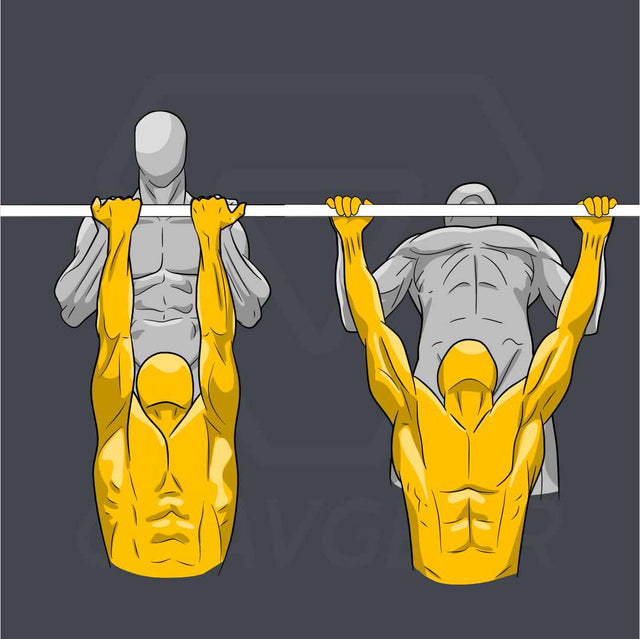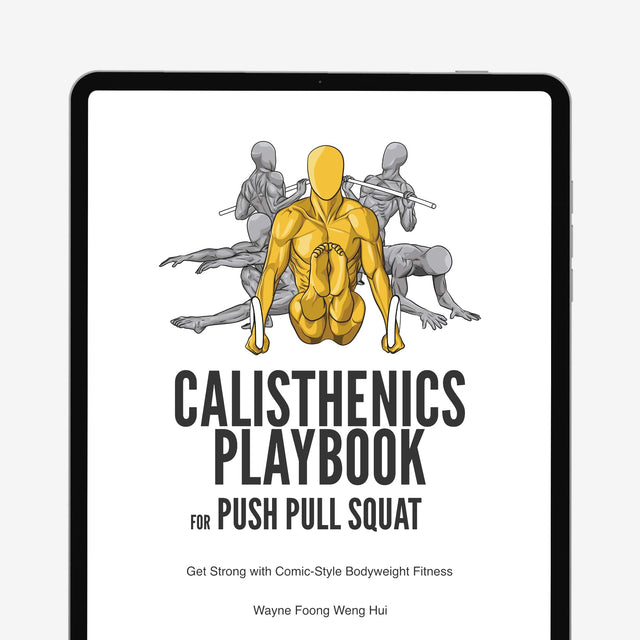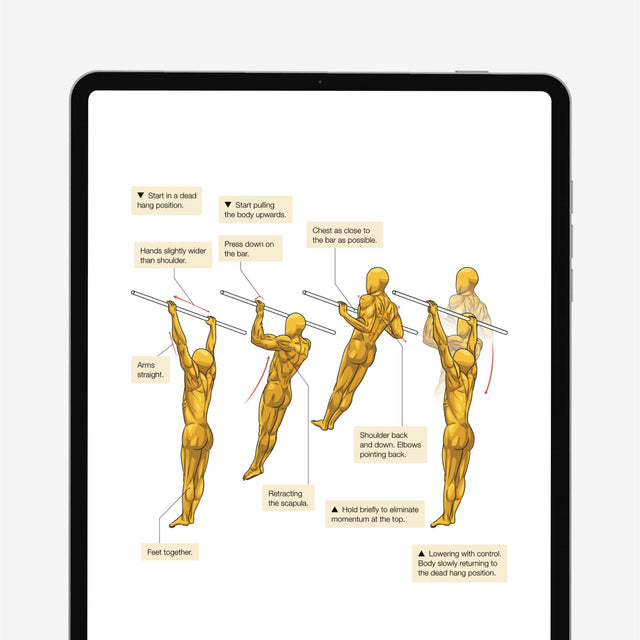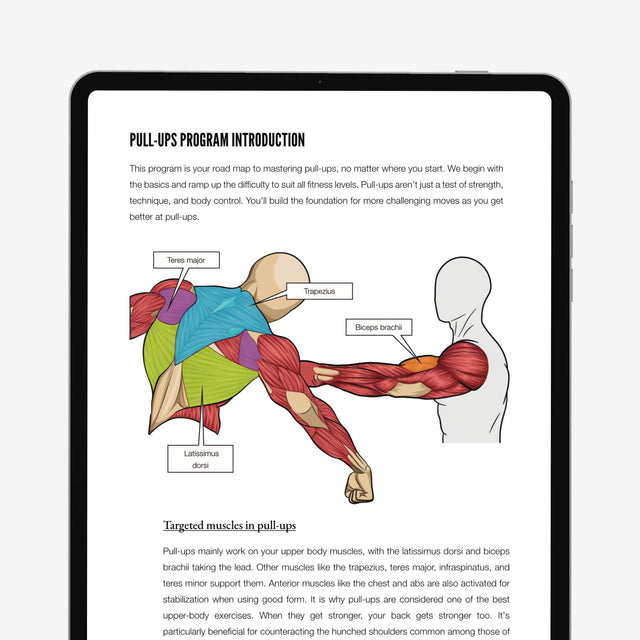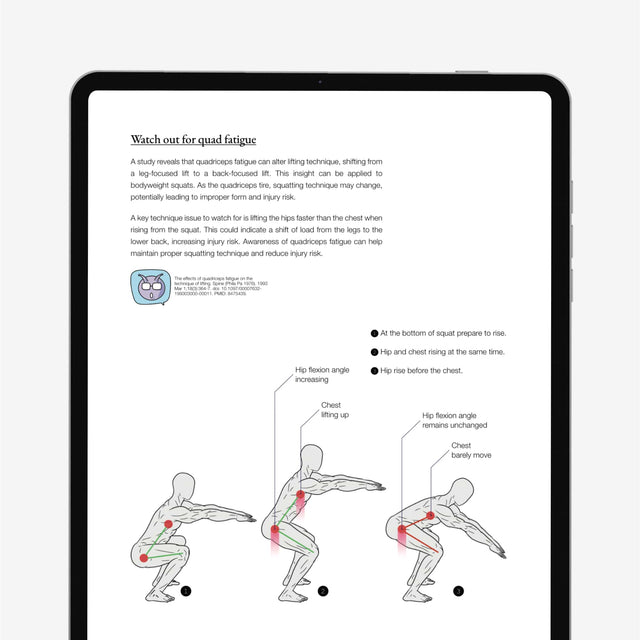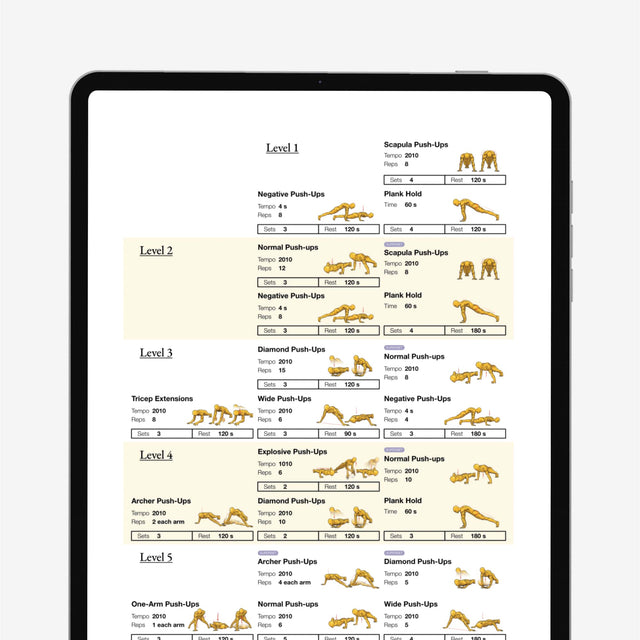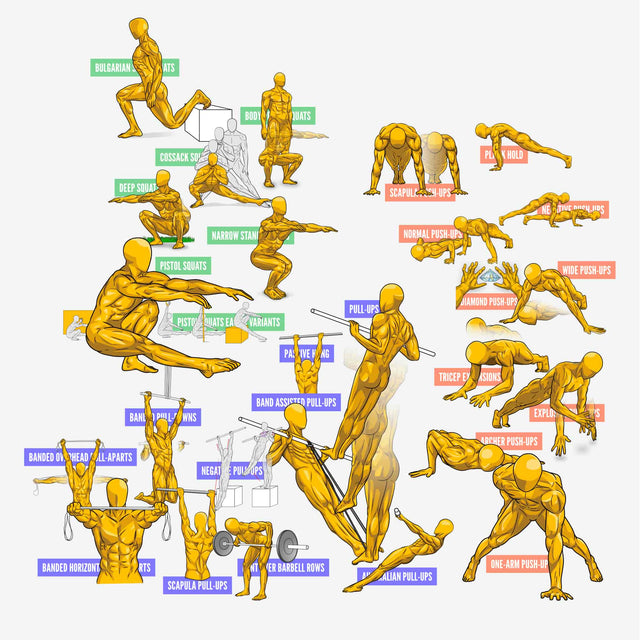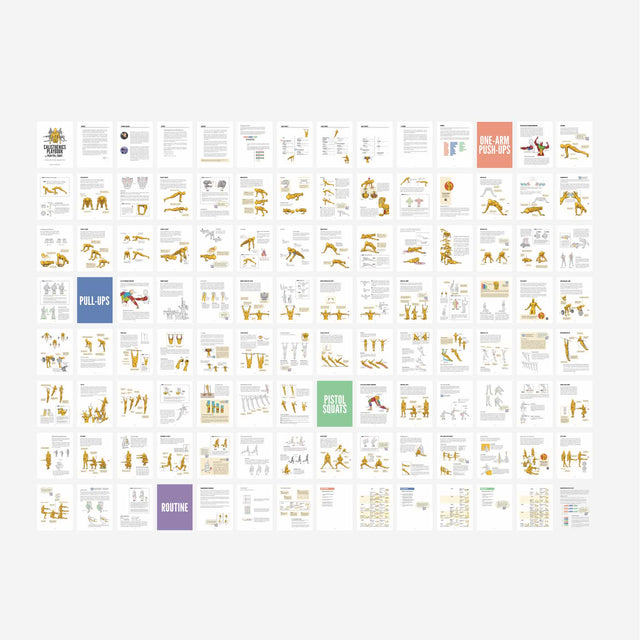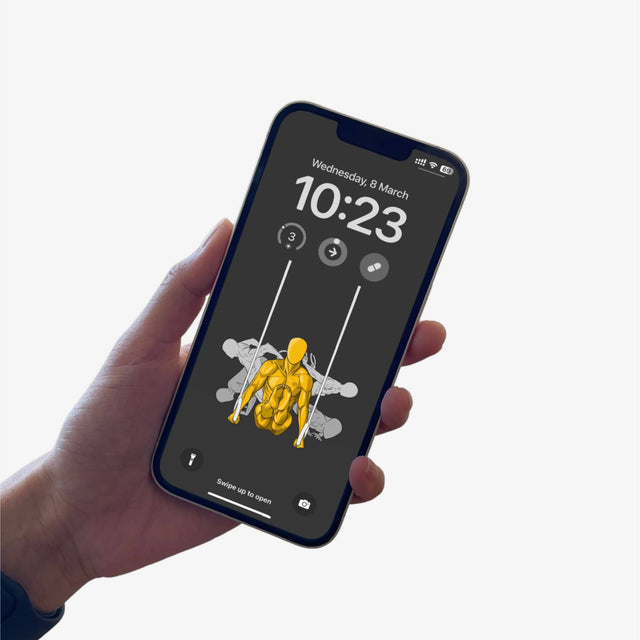Chin Ups or Pull Ups: How to Choose the Best Upper Body Exercise
There are many variations of bodyweight exercises you can do with a pull-up bar. One of the most popular is the chin-up, which is an exercise that targets your back and biceps. The opposing movement to this would be the pull-ups, which target your back, arms, and abs.
Both chin-ups and pull-ups will work your back evenly. While chin-up focuses more on the biceps brachialis, and pull-up on the lower trapezius.
Want to know more about which one should you choose chin-up vs. pull-up? Read on.
- What is chin up?
- What is a pull-up?
- Difference between chin-ups and pull-ups?
- Chin-up and pull-up uses these 5 muscles
- Chin-ups work more chest and biceps
- Pull-ups work more the lower traps
- Neutral grip works the same muscles as chin-up
- Chin-up vs Pull-up, which one is best for you?
- Chin-ups and pull-ups work the lats equally
- How to do a chin-up & pull-up?
- Tips for doing the exercise correctly
- What if you are not ready for pull-up yet?
- How do I get strong enough to do chin-ups?
- What is a good number of chin up?
- Do chin-ups build mass?
- Are chin-up better than biceps?
- Is 20 pull-ups a lot?
- Can I do pull up every day?
- Conclusion
What is chin up?

Chin-ups are done by gripping the bar with a supinated grip and pulling yourself up until your chin is above the bar. This exercise is very similar to pull-ups, but the difference is that when doing chin-ups your palms are facing you.
It is a common workout where you use your own body weight for resistance. Pulling up to the pull-up bar and slowly release to the bottom.
What is a pull-up?

Pull-ups are basically the same move as chin-up except that your palms are facing away from you, which is often called pronated grip. Pull-up targets different upper body muscles as chin-ups, and it's a bit more challenging because of this difference.
Difference between chin-ups and pull-ups?
The main difference between these 2 exercises is the grip we use on the bar. The palm-facing direction means quite a lot when it comes to the muscle group you are targeting.
There are 3 types of grip:
Pronated grip

Or overhand grip. We use this grip in pull-ups.
The palms are facing away from you throughout the whole exercise. To perform a perfect overhand grip, most of your palm should be on top of the bar. The finger knuckles should be pointing to the sky instead of sideways.
Advantages of the pronated grip are that it engages more back muscles than underhand and neutral grip.
This type of grip is less friendly for someone with shoulder problems such as rotator cuff injuries.
Supinated grip

The underhand is the reverse of the overhand. It becomes a chin-up workout if you use this grip. The palm is facing towards you during the entire workout.
It uses most force from the biceps brachialis and activates the anterior chain better. The more you place the elbows in front of you (the narrow the grip), the easier you are going to perform the chin-up.
Neutral grip

This is where you hold the bar with your palms facing each other, also known as hammer grip. It's a bit easier to perform this exercise with a neutral grip because it requires less bicep strength in order for you to pull yourself up.
Monkey bars and gymnastic rings are common tools to perform neutral grip.
Note that if you use gymnastic rings, you will mix all the grips together when doing a pull-up as the rings will rotate according to your wrist motion (thus it is more comfortable).
Chin-up and pull-up uses these 5 muscles
Both exercises can both be considered full-body workouts because you need to engage most of the bigger muscles group with perfect form.
But there are five primary muscles for the exercises that execute most of the pulling forces.
Latissimus dorsi

Whenever you are pulling something heavy with your arms, you are activating your latissimus dorsi which is also known as lats. The muscle starts from under the armpit and goes all the way down to your lower back. It's a really big group of muscles that provides us with stability, strength in movement, and posture.
Biceps brachialis

This is one of two main muscles you target when doing pull-ups or chin-ups. This muscle starts from the shoulder and goes all the way down to your elbow and it's responsible for allowing us to bend our elbows.
Erector spinae

This is the second muscle that helps us with our pulling force. It's located on your lower back, runs along the spine, and provides stability to support the movement of your body.
Pectoralis major

Also known as "pecs", they form most of our upper chest muscles. This muscle group is responsible for pectoral and shoulder movement. Chin-up benefits from this muscle more than the pull-up.
Lower trapezius

This muscle is responsible for pulling your scapula up towards the midline of your body. It's one of the biggest muscles on our back and it provides us with strength to lift heavy objects overhead, shrug shoulders or just carry weight around.
Chin-ups work more chest and biceps
In 2010, a study shows that chin-ups increase recruitment of chest (pectoralis major) and biceps (biceps brachialis).

When we are doing a chin-up, the supinated grip puts our elbows in front of the body. As a result, the lever arm is increasing during the pulling phase. Due to the fact, our trunk is angled, it activates the pecs muscle more than pull-ups.
Chin-ups work the anterior chain the most than pull-up and neutral grip. And we tend to use narrower grip in chin-up.
That said, some advanced skills like L-sit pull-ups are better to perform with a chin-up grip. You will notice L-st dead-hang from the bar is much easier with an underhand grip than the overhand-grip.
Pull-ups work more the lower traps
The pronated grip in pull-ups targets the trapezius muscles which is hard to activate by chin-up. This muscle is in charge of pulling the scapula up to the midline. It's also responsible for stabilizing your shoulders during movement.

When doing pull-ups, the scapulae are more upward (in external rotation) at the start of the concentric phase. This means that our lower trapezius will undergo greater stretch during this part which leads to higher activation levels.
Neutral grip works the same muscles as chin-up
According to the same research, the neutral does not seem to provide better muscle activation. Same as pronated grip and supinated grip, the neutral grip triggers the lats muscles in equal level.
Another research says that pull-up with neutral grip is more like chin-up, which recruits the biceps and pecs more than regular pull-ups. And it activates the posterior deltoid significantly higher than chin-up.
According to my experience, the neural grip feels almost the same as chin-up in terms of difficulty and muscle activation. So you may simply choose whether to use pronated grip or neutral grip depending on your preference.
Chin-up vs Pull-up, which one is best for you?
There is no "best" way to do a chin-up or pull-up as they both have benefits and disadvantages.

Do chin-up if you want big biceps
Chin-up is much easier to perform than pull-up, I think we can all agree on that. That's the reason chin-up is one of the pull-up alternative workouts if your upper body strength is not strong enough.
Chin-up also put lesser stress on the wrist than a pronated grip in a pull-up.
If you are a beginner, it's better to start with chin-ups. It allows you to work your way up to pull-ups or more advanced movements like L-sit chin-up.
Do pull-up if you want a super strong back
Pull-up is more difficult than chin-up. Because when we use a pronated grip, we move away from the stronger biceps and start to use more of the weaker traps muscles.
One caveat, Most people can't seem to work out their lower trapezius as well as the upper one due to its location and small size. You may not feel much difference when doing pull-ups and chin-ups if you don't apply the "chest to bar" technique.
Squeeze your shoulder blades as hard as you can, and bringing your chest to the bar is the best way to train the trapezius than anything else.
If you are into climbing sport, pull-ups are definitely a must-have in your workout routine. Pronated pulls are the most natural form of climbing. It's very rare to overcome an obstacle in the wild with a supinated grip.
Chin-ups and pull-ups work the lats equally
If you still have a hard time choosing between chin-up and pull-up. Don't need to be.

No matter which version of pull-up you do, they work the lats the same. Both chin-up and pull-up are fantastic exercises that will give you the V-shape back.
Just pull up with any grip according to your preference.
How to do a chin-up & pull-up?

Now we know the only difference between chin-up vs pull-up is just the grip. The remaining of the pulling action is almost the same as follows:
- Use pronated grip for pull-up, supinated grip for chin-up.
- At starting position, grip the bar firmly at shoulder width. You may use the narrow grip for chin-up.
- Arms straight, engage your shoulder blades by pressing them back and down to get into an active hang position.
- Concentrating on pulling up through elbows to bring chest close or touching bar for chin-up. The pulling motion should be fast and explosive.
- Hold for 2 seconds at the top position. Then slowly lower back to starting position.
Tips for doing the exercise correctly
Here are some extra tips for the perfect pull-up and chin-up:
- Try not to swing too much at both chin-up and pull-up.
- Engage your core and keep it tight.
- Keep your shoulders under tension at all times during pull-up movements by engaging the shoulder blades.
- Do chin-ups more often than pull-ups, especially if you want to work your biceps harder or are just starting out with working on that V-shape look for arms.
- If you have wrist injuries, avoid doing pronated grip of the pull-up and stick to neutral hand position instead.

What if you are not ready for pull-up yet?
Use pull-up alternative exercises. Practice the alternative workouts until you can at least perform them with 10 reps in a row.
Just so you know, chin-up is also a great pull-up alternative exercise. Other equivalent workouts that would help in getting your first pull-up are:
- inverted rows
- negative pull-up
- bicep curl
- rope climbs
These exercises trains the same muscles groups that is needed in pull-up. Hence the strength gain is transferable to pull-up when you are getting stronger.
How do I get strong enough to do chin-ups?
Fact is, chin-up can also be challenging for untrained beginners and ladies. Dead-hang is a great start.

Simply find a pull-up bar, jump up to the bar and hang for a certain period of time. You can gradually increase the time as you get stronger.
A few tips on the dead hang:
- You can use whichever grips that we've discussed above
- Toes pointing downwards
- Form a straight line while hanging
- Your body should stay still and not swinging
- Bring your leg up to form a l-sit position to engage core optimally.
Once dead-hang becomes easy, do negative chin-up slowly and steadily to up your strength level. Just jump up on a pull-up bar and try to resist gravity by resisting at the bottom position for a certain period of time before returning back to starting position carefully.
What is a good number of chin up?
There is no certain number for this question. According to my peers, I would say an active man should be able to do 10 chin-ups with fast motion. With perfect techniques, the number could probably be lower to 5.
For ladies, I would say it will be quite impressive even they can only do 1 chin-up.
Do chin-ups build mass?
Yes, chin-up does build muscle mass for sure! Resistance is resistance. Chin-up stresses the upper back the same as pull-up does, plus it hits the biceps and chest as a bonus. Many has build amazing aesthetic body with just calisthenics, and chin-up is one of the most fundamental workout.
Once you can do more than 10 chin-ups with ease, then your body will start to look like a V-shape thanks to the strong lats. And you may want to look for overload your chin-up with weighed vest.
Are chin-up better for biceps?
Yes, if you want to mainly train the biceps while practicing body awareness.
Chin-up is a compound exercise and it also hits the biceps. It does more than just work out your arms since you can't avoid using your back muscle to pull yourself up as well.
If you are looking for maximum hypertrophy and isolate the biceps, then biceps curls with weights will be a better option.
Is 20 pull-ups a lot?
If you can pull off 20 pull-ups in a row, I guess you can be much stronger than the average joes. Unless you are surrounded by a group of fitness enthusiasts.
So yes, 20 pull-ups are considered an impressive number and you better make sure your form and technique are on point as well.
Can I do pull up every day?
It depends on your level.
For total beginners, it is not recommended. As the primary muscles need time to adapt and recover.
For veterans who can pull up at least 5 in a row, it is fine to do pull-ups at least once a day. Make sure you don't train to failure if you pull up every day. This is a great way to add up training volume.
Conclusion
Chin-up and pull-up are two of the best exercises you can do for back upper body strength training.
Both chin up and pull up work out different muscle groups, but if you want to focus more on biceps go with chin-ups. If pull-up and harder pulling exercises like muscle-up is your goal, stick with pull-ups.

